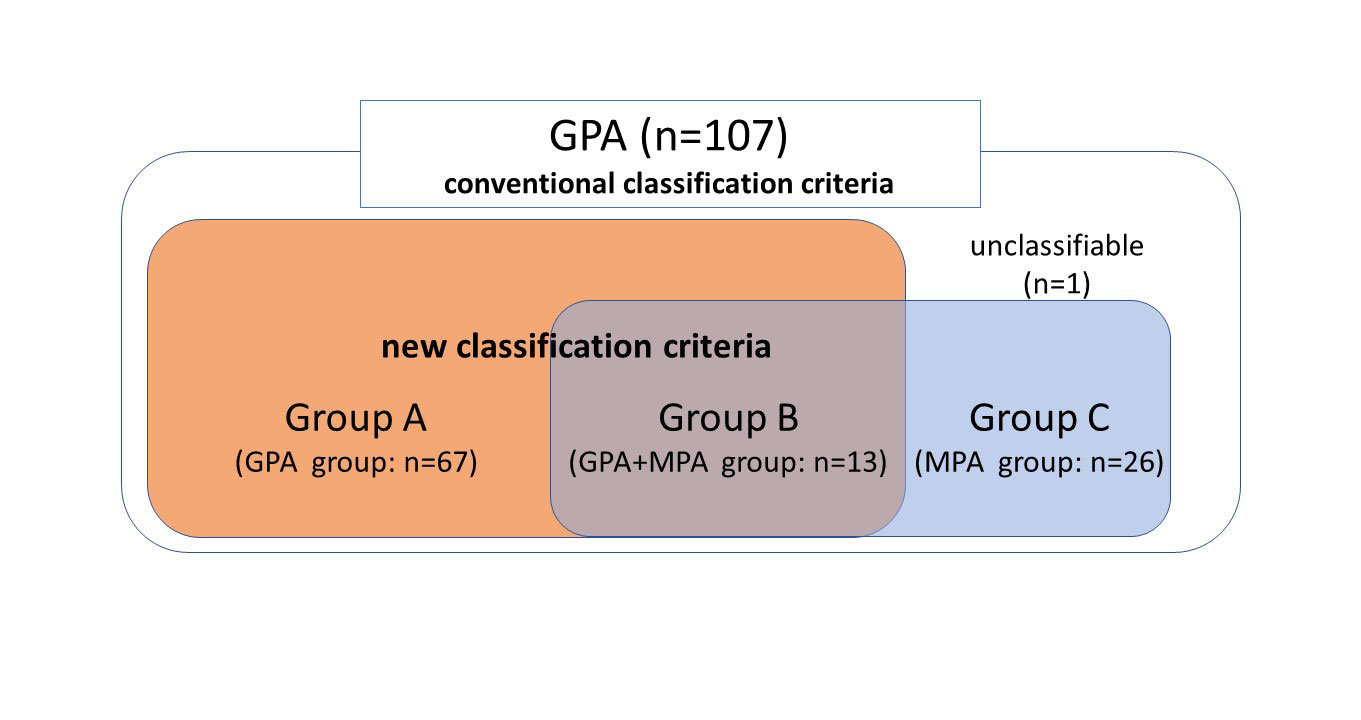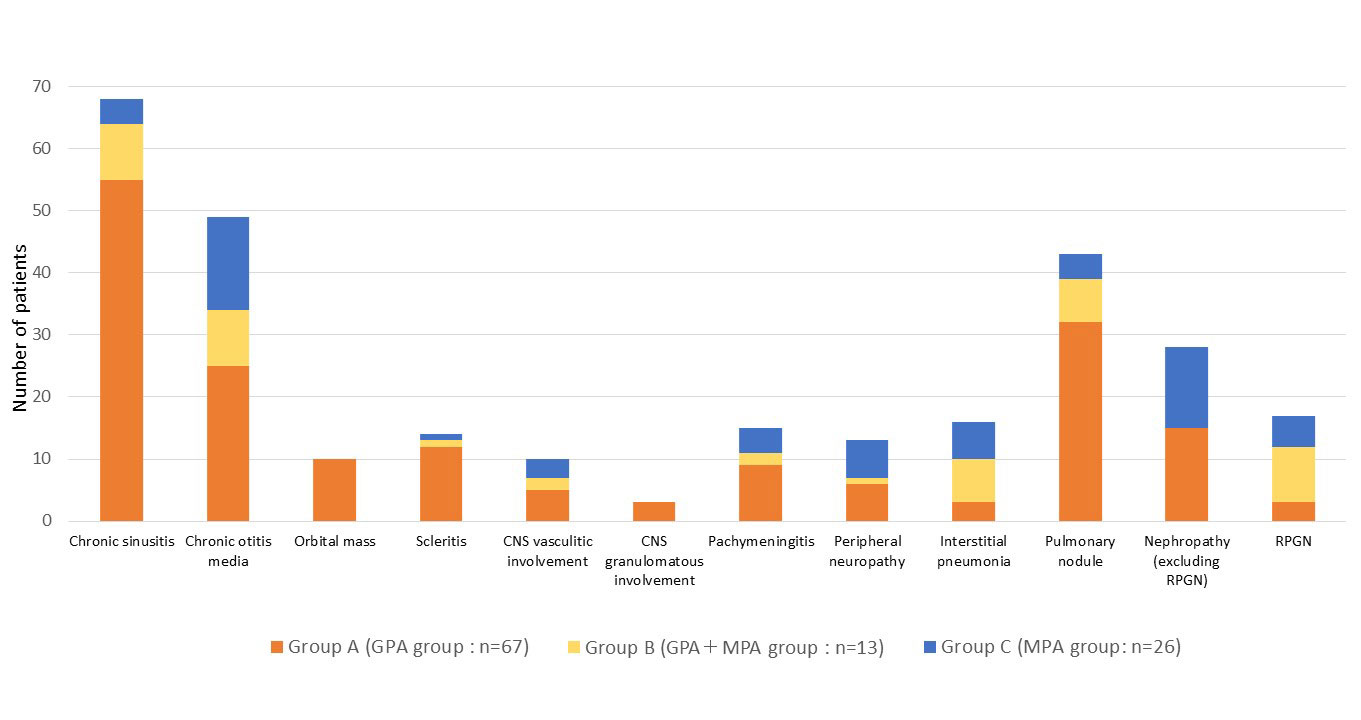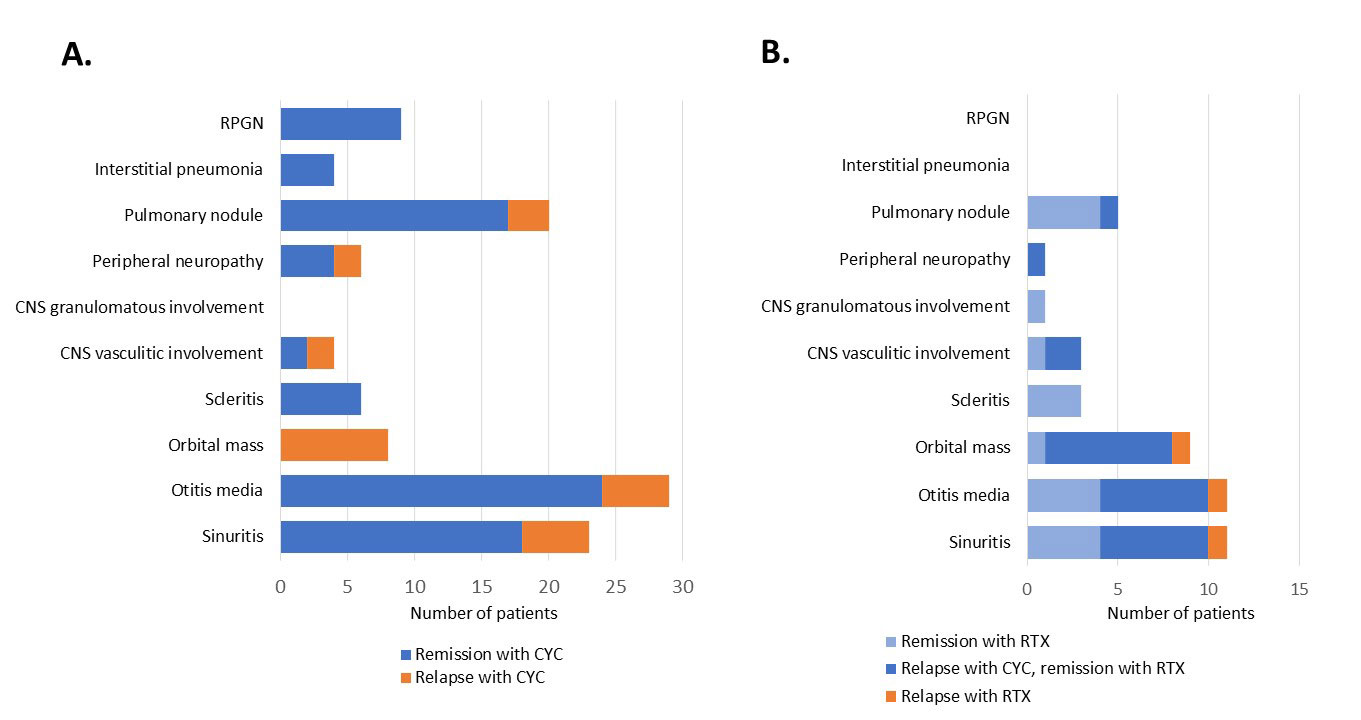Session Information
Date: Saturday, November 12, 2022
Title: Vasculitis – ANCA-Associated Poster I: Epidemiology, Outcomes, and Classification
Session Type: Poster Session A
Session Time: 1:00PM-3:00PM
Background/Purpose: The Chapel Hill Consensus Conference and the European Medicines Agency algorithm were commonly used to diagnose patients with granulomatosis with polyangiitis (GPA) 1). Recently the 2022 ACR/EULAR classification criteria for ANCA-associated vasculitis have been released2)3). It is well-known that in the U.S. and Europe GPA patients are predominantly PR3-ANCA-positive, but in Japan MPO-ANCA-positive GPA patients are more prevalent. It is also reported that PR3-ANCA-positive GPA patients have a poorer prognosis than MPO-ANCA-positive GPA patients. In this study, we aimed to investigate advantages and disadvantages in applying the new classification criteria to Japanese conventionally-diagnosed GPA patients through the analysis of ANCA subtypes and the patterns of organ lesions.
Methods: We retrospectively analyzed a total of 107 patients diagnosed with GPA according to the conventional criteria at three medical institutions in Japan between 2000 and 2021. The features of each organ lesion were analyzed after reclassification according to the 2022 ACR/EULAR classification criteria for GPA and microscopic polyangiitis (MPA).
Results: Of the 107 patients who were conventionally diagnosed with GPA, 80 patients were reclassified as GPA according to the new classification criteria (Figure 1). Of the newly reclassified 80 GPA patients, 67 patients (Group A) were not reclassified as MPA, however 13 patients (Group B) were reclassified as MPA. Twenty-six patients (Group C) of all the conventionally-diagnosed GPA patients were reclassified not as GPA but as MPA. Only one patient was not reclassified to either GPA or MPA. After application of the new classification criteria, all of the PR3-ANCA-positive patients were included in Group A. Figure 2 shows the clinical manifestations in each group. In Group A, 55 patients had sinusitis, and 10 of them had orbital mass extension with bone destruction. In Group B, 11 out of 13 patients had severe organ involvement. They included nine patients with rapidly progressive glomerulonephritis (RPGN). In Group C, 15 patients had otitis media, 13 patients had renal involvement, and only 5 patients had RPGN. The disease severity in this group were generally mild. Figure 3 shows the effects of remission induction therapy for each organ involvement with cyclophosphamide (CYC) and/or rituximab (RTX). Orbital mass lesions were so refractory that nine patients required initial remission induction therapy with CYC or RTX (eight and one patient, respectively), but in fact nine patients relapsed or exacerbated even after initial remission induction therapy with CYC, and seven patients stayed in complete remission only after the treatment with RTX. One patient responded well to initial remission induction therapy with RTX. RPGN was highly responsive to CYC.
Conclusion: The newly-reclassified GPA patients included orbital masses, which were prone to relapse after remission induction therapy with CYC but more responsive to RTX. Moreover, conventionally-diagnosed GPA patients reclassified as GPA/MPA according to the new criteria were more likely to have RPGN.
1) Ann Rheum Dis. 2007; 66: 222-227.
2) Ann Rheum Dis. 2022; 81: 315-320.
3) Ann Rheum Dis. 2022; 81: 321-326.
(A) A total of 45 patients underwent the first remission induction therapy with cyclophosphamide (CYC). This shows the effect of the first remission induction therapy with CYC.
(B) A total of 23 patients underwent remission induction therapy with rituximab (RTX) for the first time (n=5) and remission re-induction therapy after relapse following CYC induction therapy (n=18). This shows the effect of the first remission induction therapy with RTX
To cite this abstract in AMA style:
Kuwata R, Shirota Y, Shirai T, Yamashita H, Sato H, Takeda T, Oka Y, Kodera T, Kaneko H, Kameoka J, Fujii H, Ishii T. Advantages and Disadvantages in Applying 2022 ACR/EULAR Classification Criteria to Conventionally Diagnosed Japanese GPA Patients [abstract]. Arthritis Rheumatol. 2022; 74 (suppl 9). https://acrabstracts.org/abstract/advantages-and-disadvantages-in-applying-2022-acr-eular-classification-criteria-to-conventionally-diagnosed-japanese-gpa-patients/. Accessed .« Back to ACR Convergence 2022
ACR Meeting Abstracts - https://acrabstracts.org/abstract/advantages-and-disadvantages-in-applying-2022-acr-eular-classification-criteria-to-conventionally-diagnosed-japanese-gpa-patients/



